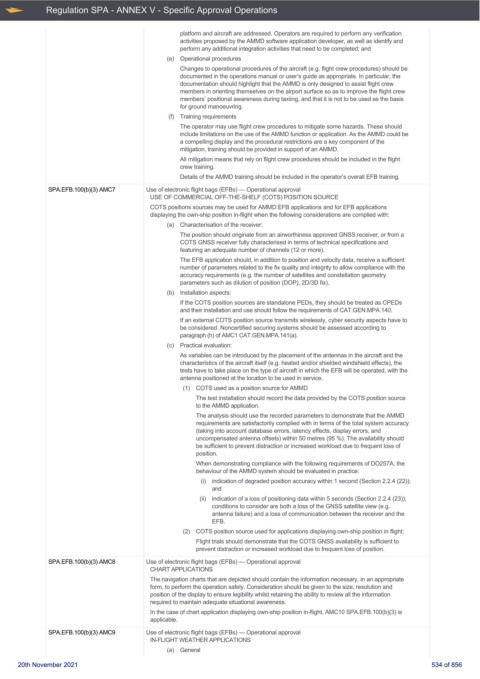Page 534 - UK Air Operations Regulations (Consolidated) 201121
P. 534
~
~ Regulation SPA - ANNEX V - Specific Approval Operations Centrik
platform and aircraft are addressed. Operators are required to perform any verification
activities proposed by the AMMD software application developer, as well as identify and
perform any additional integration activities that need to be completed; and
(e) Operational procedures
Changes to operational procedures of the aircraft (e.g. flight crew procedures) should be
documented in the operations manual or user’s guide as appropriate. In particular, the
documentation should highlight that the AMMD is only designed to assist flight crew
members in orienting themselves on the airport surface so as to improve the flight crew
members’ positional awareness during taxiing, and that it is not to be used as the basis
for ground manoeuvring.
(f) Training requirements
The operator may use flight crew procedures to mitigate some hazards. These should
include limitations on the use of the AMMD function or application. As the AMMD could be
a compelling display and the procedural restrictions are a key component of the
mitigation, training should be provided in support of an AMMD.
All mitigation means that rely on flight crew procedures should be included in the flight
crew training.
Details of the AMMD training should be included in the operator’s overall EFB training.
SPA.EFB.100(b)(3) AMC7 Use of electronic flight bags (EFBs) — Operational approval
USE OF COMMERCIAL OFF-THE-SHELF (COTS) POSITION SOURCE
COTS positions sources may be used for AMMD EFB applications and for EFB applications
displaying the own-ship position in-flight when the following considerations are complied with:
(a) Characterisation of the receiver:
The position should originate from an airworthiness approved GNSS receiver, or from a
COTS GNSS receiver fully characterised in terms of technical specifications and
featuring an adequate number of channels (12 or more).
The EFB application should, in addition to position and velocity data, receive a sufficient
number of parameters related to the fix quality and integrity to allow compliance with the
accuracy requirements (e.g. the number of satellites and constellation geometry
parameters such as dilution of position (DOP), 2D/3D fix).
(b) Installation aspects:
If the COTS position sources are standalone PEDs, they should be treated as CPEDs
and their installation and use should follow the requirements of CAT.GEN.MPA.140.
If an external COTS position source transmits wirelessly, cyber security aspects have to
be considered. Noncertified securing systems should be assessed according to
paragraph (h) of AMC1 CAT.GEN.MPA.141(a).
(c) Practical evaluation:
As variables can be introduced by the placement of the antennas in the aircraft and the
characteristics of the aircraft itself (e.g. heated and/or shielded windshield effects), the
tests have to take place on the type of aircraft in which the EFB will be operated, with the
antenna positioned at the location to be used in service.
(1) COTS used as a position source for AMMD
The test installation should record the data provided by the COTS position source
to the AMMD application.
The analysis should use the recorded parameters to demonstrate that the AMMD
requirements are satisfactorily complied with in terms of the total system accuracy
(taking into account database errors, latency effects, display errors, and
uncompensated antenna offsets) within 50 metres (95 %). The availability should
be sufficient to prevent distraction or increased workload due to frequent loss of
position.
When demonstrating compliance with the following requirements of DO257A, the
behaviour of the AMMD system should be evaluated in practice:
(i) indication of degraded position accuracy within 1 second (Section 2.2.4 (22));
and
(ii) indication of a loss of positioning data within 5 seconds (Section 2.2.4 (23));
conditions to consider are both a loss of the GNSS satellite view (e.g.
antenna failure) and a loss of communication between the receiver and the
EFB.
(2) COTS position source used for applications displaying own-ship position in flight:
Flight trials should demonstrate that the COTS GNSS availability is sufficient to
prevent distraction or increased workload due to frequent loss of position.
SPA.EFB.100(b)(3) AMC8 Use of electronic flight bags (EFBs) — Operational approval
CHART APPLICATIONS
The navigation charts that are depicted should contain the information necessary, in an appropriate
form, to perform the operation safely. Consideration should be given to the size, resolution and
position of the display to ensure legibility whilst retaining the ability to review all the information
required to maintain adequate situational awareness.
In the case of chart application displaying own-ship position in-flight, AMC10 SPA.EFB.100(b)(3) is
applicable.
SPA.EFB.100(b)(3) AMC9 Use of electronic flight bags (EFBs) — Operational approval
IN-FLIGHT WEATHER APPLICATIONS
(a) General
20th November 2021 534 of 856

